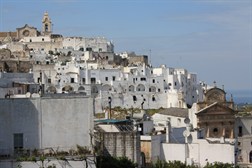Ostuni, the White City
 Ostuni, also known as the White City because of the characteristic appearance of the historic center once painted with white lime, is part of the current day province of Brindisi. Located in an area inhabited since the Paleolithic period, Ostuni was founded by the ancient people of the Messapians in the seventh century B.C. Conquered by the Romans in the third century B.C, it came under various rulers during the Middle Ages. Becoming a diocese in 876, Ostuni enjoyed a period of splendor under Emperor Frederick II (1194-1250), who freed it from feudal bonds and took the town under his personal protection, making its castle (built by Godfrey III Count of Lecce in the twelfth century), one of the pivots of imperial defence in Apulia. The new walls with circular towers date back to the Aragonese period. If the Renaissance period coincided with the period of maximum development of the city, the crisis of the seventeenth century also involved Ostuni, which was sold to the Zevallos family. The custom of whitewash houses with lime, a natural disinfectant, held the plague away from the city and gave it the characteristic that would mark it to this day.
Ostuni, also known as the White City because of the characteristic appearance of the historic center once painted with white lime, is part of the current day province of Brindisi. Located in an area inhabited since the Paleolithic period, Ostuni was founded by the ancient people of the Messapians in the seventh century B.C. Conquered by the Romans in the third century B.C, it came under various rulers during the Middle Ages. Becoming a diocese in 876, Ostuni enjoyed a period of splendor under Emperor Frederick II (1194-1250), who freed it from feudal bonds and took the town under his personal protection, making its castle (built by Godfrey III Count of Lecce in the twelfth century), one of the pivots of imperial defence in Apulia. The new walls with circular towers date back to the Aragonese period. If the Renaissance period coincided with the period of maximum development of the city, the crisis of the seventeenth century also involved Ostuni, which was sold to the Zevallos family. The custom of whitewash houses with lime, a natural disinfectant, held the plague away from the city and gave it the characteristic that would mark it to this day.
